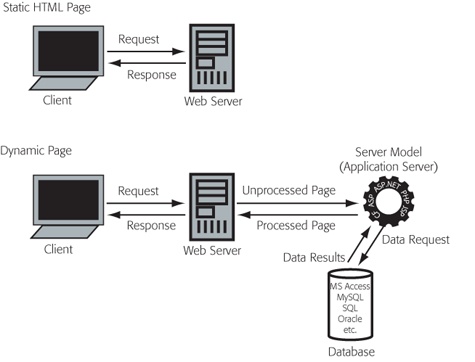Pieces of the Puzzle
Dynamic websites are more complex than simple static sites. Static sites require only the computer you use to build your pages and a web server to dish them out. In fact, as you can see by previewing your site with a web browser on your own computer, you don’t even need a web server to effectively view a static website.
Dynamic web pages, by contrast, require more horsepower and a mix of technologies (see Figure 22-2). Not only is there a web server that handles requests for web pages, but you need two other types of servers, an application server and a database server.
You’ll still use a lot of HTML (and CSS) in building a dynamic site—for example, to provide the page layout, add banner graphics, and display navigation bars. But you’ll augment that mix with some form of programming code. The application server processes that code, often retrieving information from the database server, and then it sends a completed HTML page to the web server, which, in turn, sends that page to your site’s visitor.

Figure 22-2. Top: The technology behind a website that uses plain old static HTML pages is straightforward: When you come to the site, a web server sends your computer (the client computer) the pages, graphics, and other elements of a page. Bottom: When you come to a dynamic page, on the other hand, the web server must communicate with an application server, which in turn ...
Get Dreamweaver CS6: The Missing Manual now with the O’Reilly learning platform.
O’Reilly members experience books, live events, courses curated by job role, and more from O’Reilly and nearly 200 top publishers.

